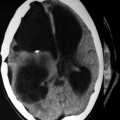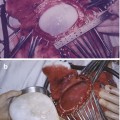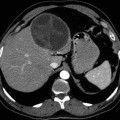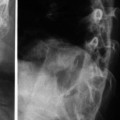Fig. 25.1
Life cycle of Echinococcus granulosus
The eggs passed in the feces of dogs are the infective stage for the intermediate host like domestic livestock, wild intermediate hosts, and humans, where the oncospheres develop into hydatid cysts (Fig. 25.1). The number of eggs produced varies between 100 and 1,500 per proglottid (Thompson 1995), and a dog may have hundreds of adult cestodes. Therefore, an infected dog can spread thousands of fertile eggs of Echinococcus that may remain viable for months in the environment.
Each hydatid cyst may have thousands of protoscolices in brood capsules. When dogs ingest raw offal containing hydatid cysts from intermediate hosts, each evaginated protoscolex attaches between the villi of the small intestine and, in about 40 days, develops a mature adult tapeworm. An interesting fact is that the protoscolices of E. granulosus have a double biotic potential: if ingested by dogs, they result in adult worms, but if they fall into serous cavities (e.g., pleural or peritoneal cavities) of an intermediate host, including man, they can redevelop into a new cyst (secondary hydatidosis).
Control
Approaches and Options
According to Gemmell and Schantz (1997), control may be defined as an active implementation of a program to limit the prevalence of a specific disease by a recognized authority on an instruction from the legislature. It is different from eradication that Gemmell and Schantz (1997) defined as the purposeful reduction of specific disease prevalence to the point of continued absence of transmission within a specific area by means of a time-limited campaign.
The preventive and control programs require interrupting the life cycle of the parasite acting on the epidemiological chain. For this it is necessary to act on the following: (a) the definitive hosts (dogs and other canids); (b) the herbivorous intermediate hosts such as sheep, cattle, and goats and a rather large number of other suitable hosts such as camels, pigs, horses, etc.; (c) the human population; and (d) other stages of the life cycle.
Since 1863 several programs of control have been employed in many countries. Several of them have been employed in islands such as Iceland (1863–1960), New Zealand (1938–2002), Tasmania (1964–1996), Falkland Islands (1965–1997), Cyprus (1971–1985), and Sardinia (1960–1997), with different efficacy reviewed by Craig and Larrieu (2007).
From the analysis of the control programs developed in continental and insular countries, it is apparent that two main approaches were employed (Gemmell and Schantz 1997; Gemmell 2001): (a) a “horizontal” approach based on health education, sanitation improvement, meat inspection and slaughterhouses facilities, and developing safe water supplies and (b) “vertical” approach that targets the parasite by testing dogs, regular dosing of dogs with praziquantel, and massive reduction of dog populations, including baseline surveys and continuing surveillance of livestock and human infections. These approaches are not mutually exclusive (Gemmell and Schantz 1997; Gemmell et al. 2001). Certainly, the “horizontal approach” is cheaper than the “vertical” approach.
According to Gemmell and Schantz (1997) and Gemmell et al. (2001) and based on previous experiences, the control programs can be divided into four phases: (a) planning phase, (b) attack phase, (c) consolidation phase, and (d) maintenance of eradication phase. During the planning phase, the support of the control authority must be obtained, and the plan should establish methods of control, cost-benefit ratios, and the extent and duration of the program.
In the attack phase, the control measures to be applied must be targeted to the parasite and its definitive hosts; this includes dog-dosing campaigns with praziquantel, massive reduction of dog populations, regulation on dog feeding practice, ruling the keeping of dogs, and introducing an obligatory dog license fee that allows to create a record of rural and urban dogs. This is a costly phase.
In the consolidation phase, the campaign must be focused on at-risk areas as farms are identified using trace-back of the livestock through slaughterhouses surveillance. A trace-forward of the livestock of these farms must be also implemented. During this phase the quarantine of infected farms is important and the dog registration should continue.
The maintenance of eradication phase can begin once the parasite has been potentially eliminated. During this phase, specific activities of previous phases cease, and vigilance activities are employed (e.g., trace-back from slaughterhouses). It is important that the dog registration still takes place during this phase (Gemmell and Schantz 1997; Gemmell et al. 2001). During the planning or preparatory phase taking into account the cost-benefit ratios, five options can be discerned (Gemmell and Schantz 1997; Gemmell et al. 2001):
Option 1: No control, for a variety of reasons such as lack of resources.
Option 2: Implement a horizontal approach.
Option 3: A slow attack option oriented toward preventing the dog’s infection from raw offals by testing dogs and creating legislation for quarantining farms still harboring infected animals. This slow attack option may last for more than 30 years.
Option 4: A fast attack option A, which includes an educational approach, legislation, and surveillance of the human and animal population, as in option 3, but in addition the dog population must be drastically reduced. This attack phase can last more than 30 years.
Option 5: A fast attack option B, where all dogs are treated with praziquantel at predetermined intervals. The duration of this attack phase may be as short as 10–15 years. According to Gemmell and Schantz (1997), options 3, 4, and 5 are “vertical” approaches.
Craig and Larrieu (2007) summarize and simplify the approaches to control in slow track and fast track. The slow-track relies on specific health education, meat inspection, and upgrading of slaughterhouses. This approach was the only one employed in the Iceland program for many years and was successful (Craig and Larrieu 2007); however, most authors consider that the use of slow track as the sole tool of control does not lead to a significant reduction in transmission (Gemmell and Schantz 1997; Lloyd et al. 1998; Craig and Larrieu 2007). On the other hand, Wales’ experience showed that although the unique use of education failed to reduce the transmission of echinococcosis, it had a positive effect on the praziquantel dosing of dogs by the farmers (Lloyd et al. 1998). The fast-track option leads to a shorter time to control the transmission of echinococcosis.
Based on the proposal of Gemmell et al. (2001), Craig and Larrieu (2007) described better the options for control of echinococcosis, which are as follows:
Option 1: Decision not to proceed because CE is not a public health problem, funding is not available, socio-economics features, and other reasons.
Option 2: Implementation of a long-term (slow-track) approach. Experience in some countries indicates that it would require 30–100 years to be fully implemented.
Option 3: Vertical slow-track approach incorporating at least annual testing of dogs together with on-site education of owners and quarantine of positive dogs.
Option 4: Vertical fast-track approach with elimination of stray dogs and euthanasia of positive dogs. Employed in Cyprus, this approach was effective after 10–15 years.
Option 5: Vertical fast-track approach including regular treatment of all registered dogs with praziquantel. Employed in New Zealand after 1990, it was effective after 10–15 years.
Health Education
Health education, as mentioned, is one of the tools for the control and prevention of echinococcosis, both in slow-track and fast-track approaches. Even in some control programs, such as Iceland (1863–1960), it was the only action taken during many years, and it recorded good results. Health education is a multidisciplinary activity, which requires knowledge of medical sciences, teaching, and communication methods. For the purposes of this paper, health education is defined as a specialty that uses educational principles to promote changes in behavior with regard to health in the individual and the community.
According to Parodi et al. (2001), health education includes three types of activities that tend to be dependent on one another:
1.
Information: It involves the transfer of expert knowledge to the group targeted. This activity aims to highlight certain points to get the community to actively participate in preventive actions.
2.
Health education sensu strictu: It is aimed to target groups who are not professionally concerned about the problem, such as schoolchildren or the public at large.
3.
Occupational training: It targets those who must implement health standards in their professional activities (e.g., farmers and butchers).
The objectives of health education are for the community to support the programs and to be able to influence the importance of health priorities (Parodi et al. 2001). Therefore, health education must be included in all control programs previously defined. It is necessary to enhance the use of new technologies of communication and the spread of knowledge.
Costs and Benefits
The cost-effectiveness analysis and cost-benefit analysis are important tools to compare alternative echinococcosis control programs. For an economic evaluation it will be necessary to estimate the costs of the control program and losses produced by the disease (Nonnemaker and Schantz 1997). There are three types of costs to evaluate: (a) costs of CE in humans, (b) costs of the disease in animals, and (c) costs of the control program.
The cost of control programs must be evaluated realistically, taking into account that there are programs that will be necessary to implement over many years, supported by government budgets. Per Nonnemaker and Schantz (1997), the cost-benefit analysis is more comprehensive than cost-effectiveness analysis, and it determines if the net benefits of a control program outweigh the net cost to society. Whenever possible, the interruption of a control program for lack of funds should be avoided; sufficient funding from the legislature to complete this period of the program should always be in place. Loss of confidence by the government, resulting from inadequate data about evidence of success in the program, may result in a premature withdrawal of funding (Gemmell et al. 2001). To obtain sufficient funds in the budget, it is necessary to make a good analysis of the costs and benefits of the program because an economic evaluation of the effect of the disease should be an integral part of any control program. Therefore, it is necessary to sustain with data that CE has an important economic impact on human health and livestock production (Torgerson 2003a). Human health costs include human morbidity and mortality cost. Morbidity costs should include costs of diagnosis, surgical and medical treatments, nursing care, and paid sick leaves. It must also be considered that hydatidosis is a long-term disease that affects the quality of life both in undiagnosed individuals and in surgically treated individuals (Torgerson and Dowling 2001). The burden of CE may be also estimated using nonfinancial metrics such as the disability-adjusted life year (DALY) defined as a measure of overall disease burden and expressed as the number of years lost due to ill-health, disability, or early death, as proposed by Torgerson (2011). As Torgerson (2003b) said, the mortality costs are difficult to calculate because the value of life is a controversial subject and has been calculated in a number of ways. Because of these difficulties many economists prefer to use the concept of DALYs. It should be noted that the costs of human health are very different in poor countries as compared to the rich developed countries.
The cost estimates for livestock production are based on prevalence of CE in livestock, the value of livestock-related products, and an evaluation of likely production losses. It is accepted that infected animals have a reduction in the growth, milk production, and fecundity. Moreover, after inspection at slaughterhouses, the infected viscera (mainly the liver and lungs) are confiscated and destroyed. Because of all these factors, CE has important costs in livestock.
In a study made in Jordan, a country of lower-middle income with a population of 5,100,981, Torgerson et al. (2001) estimates annual economic loss attributable to hydatidosis in animals and humans from US$ 2,602,215 to 6,533,661 with a median of US$ 3,874,070. In another study made in Wales, an endemic region of the United Kingdom, a wealthy and industrialized economy, Torgerson and Dowling (2001) estimate an annual human cost of hydatidosis of US$ 1million and perhaps as much as US$ 7.9 million. In Spain, a European country with 47,021,031 inhabitants, a study made by Benner et al. (2010) estimates the overall economic loss attributable to CE in animals and humans in 2005 at 148,964,534 euros. In China, in the province of Sichuan, with 84 million inhabitants, a study made by Budke et al. (2005) quantified the annual combined human and animal economic losses by CE at US$ 218,676 if only liver-related losses in sheep, goats, and yaks are taken into account. However, total annual losses can be nearly US$ 1 million if additional livestock production losses are assumed. Data such as those presented above serve as examples of arguments that must be handled with the government authorities to justify the cost of control programs.
Pharmacological Treatment of Dogs
The antihelminthic treatment of dogs is included in all programs of control. The drug of choice is praziquantel (5 mg/kg/bw) administered orally at intervals of 6 weeks. This interval was based on the prepatent period of infection with E. granulosus and has proven to be effective in preventing transmission Cabrera PA et al. (2002). Depending on the program of different countries, the praziquantel dosing is done by the owners of the dogs or by technicians in charge of the program, and the drug may be free or payable by owners.
Reduction of Dog Population
The reduction of dog population was implemented in some programs. A massive reduction of dog population was employed in the control program of Cyprus between 1970 and 1985. The drastic measure taken was the elimination of stray and unattended dogs. During the first year of the campaign, more than 18,000 stray and unattended dogs were killed. All dogs that tested positive for E. granulosus were also killed, and a dog registration fee was introduced (Craig and Larrieu 2007). This massive killing of dogs is not currently accepted.
In the current Control Program of Echinococcosis in Uruguay, since 2007, they have introduced a voluntary and free surgical castration of owned dogs. The spaying of stray dogs is also performed. The spaying is performed in dogs of both sexes by veterinarians in mobile units throughout the country. From January 2007 to October 2011, 100,440 dogs have been spayed. This action has the approval of the Society for the Protection of Animals of Uruguay and is made together with a campaign on responsible dog ownership (Ferreira and Irabedra 2007; Guisantes 2009; Purpura 2011).
Stay updated, free articles. Join our Telegram channel

Full access? Get Clinical Tree








